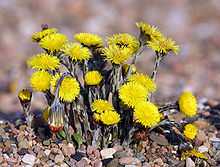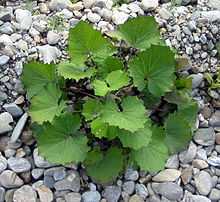Tussilago
| coltsfoot | |
|---|---|
 | |
| Scientific classification | |
| Kingdom: | Plantae |
| (unranked): | Angiosperms |
| (unranked): | Eudicots |
| (unranked): | Asterids |
| Order: | Asterales |
| Family: | Asteraceae |
| Tribe: | Senecioneae[1] |
| Genus: | Tussilago L. |
| Species: | T. farfara |
| Binomial name | |
| Tussilago farfara L. | |
| Synonyms[1] | |
| |
Tussilago farfara, commonly known as coltsfoot, is a plant in the groundsel tribe within the sunflower family. It has traditionally had medicinal uses. However, the discovery of toxic pyrrolizidine alkaloids in the plant has resulted in liver health concerns. The name "tussilago" is derived from the Latin tussis, meaning cough, and ago, meaning to cast or to act on.[2][3]
Tussilago farfara is the only accepted species in its genus, although more than two dozen other species have at one time or another been considered part of this group. Most of them have now regarded as members of other genera (Chaptalia Chevreulia Farfugium Homogyne Leibnitzia Petasites Senecio).[1]

Coltsfoot is a perennial herbaceous plant that spreads by seeds and rhizomes. Tussilago is often found in colonies of dozens of plants. The flowers, which superficially resemble dandelions, appear in early spring before dandelions appear. The leaves, which resemble a colt's foot in cross section, do not appear usually until after the seeds are set. Thus, the flowers appear on stems with no apparent leaves, and the later appearing leaves then wither and die during the season without seeming to set flowers. The plant is typically 10–30 cm in height. The leaves have angular teeth on their margins.[4]
Distribution
Coltsfoot is widespread across Europe, Asia, and North Africa, from Svalbard to Morocco to China and the Russian Far East. It is also a common plant in North America and South America where it has been introduced, most likely by settlers as a medicinal item. The plant is often found in waste and disturbed places and along roadsides and paths. In some areas it is considered an invasive species.[1][5][6]
Synonym
Other common names include tash plant, ass's foot, bull's foot, butterbur, coughwort (Old English),[7] farfara, foal's foot, foalswort, horse foot and winter heliotrope. Sometimes it is confused with Petasites frigidus, or western coltsfoot.
It has been called bechion[8] bechichie or bechie, from the Ancient Greek word for "cough".[9] Also ungula caballina ("horse hoof"), pes pulli ("foal's foot"),[8] and chamæleuce.[10]
Traditional uses
Coltsfoot has been used in herbal medicine[8] and has been consumed as a food product with some confectionery products, such as Coltsfoot Rock. Tussilago farfara leaves have been used in the traditional Austrian medicine internally (as tea or syrup) or externally (directly applied) for treatment of disorders of the respiratory tract, skin, locomotor system, viral infections, flu, colds, fever, rheumatism and gout.[11]
Food source
Coltsfoot is used as a food plant by the larvae of some Lepidoptera species including the gothic and small angle shades. The coltsfoot is also worked by the honey bee (Apis mellifera mellifera).
Toxicity
Tussilago farfara contains tumorigenic pyrrolizidine alkaloids.[12] Senecionine and senkirkine, present in coltsfoot, have the highest mutagenetic activity of any pyrrolozidine alkaloid, tested using Drosophila melanogaster to produce a comparative genotoxicity test.[13][14] There are documented cases of coltsfoot tea causing severe liver problems in an infant, and in another case, an infant developed liver disease and died because the mother drank tea containing coltsfoot during her pregnancy.[15][16] In response the German government banned the sale of coltsfoot. Clonal plants of colstfoot free of pyrrolizidine alkaloids were then developed in Austria and Germany.[17] This has resulted in the development of the registered variety Tussilago farfara 'Wien' which has no detectable levels of these alkaloids.[18]
References
- ↑ 1.0 1.1 1.2 1.3 Flann, C (ed) 2009+ Global Compositae Checklist
- ↑ Capasso, Francesco (2011). "Capitolo M12: Droghe obsolete e/o poco studiate". Farmacognosia: Botanica, chimica e farmacologia delle piante medicinali (in Italian) (Seconda edizione ed.) (Springer Milan). p. 428. doi:10.1007/978-88-470-1652-1_30. ISBN 978-88-470-1652-1 http://books.google.com/books?id=qn5zb3_rqZIC&pg=PA428.
Tussilago, dal latino tussis = tosse e ago = scaccio.
Missing or empty|title=(help) - ↑ Booth, David (1835). An analytical dictionary of the English language. James Cochrane and Co. p. 312.
Tussilago, from the Latin tussis, a cough, and ago, to act upon, to cure; from its reputed virtues.
- ↑ Theodore M. Barkley (2006). "Tussilago Linnaeus, Sp. Pl. 2: 865. 1753; Gen. Pl. ed. 5, 372. 1754". Magnoliophyta: Asteridae, Part 7: Asteraceae, Part 2. Flora of North America 20. Oxford University Press. p. 635. ISBN 9780195305647.
- ↑ Flora of China Vol. 20-21 Page 461 款冬 kuan dong Tussilago farfara Linnaeus, Sp. Pl. 2: 865. 1753.
- ↑ Altervista Flora Italiana, genere Tussilago includes photos and distribution maps
- ↑ Coulombe Jr., Roger A. (2003). "Pyrrolizidine Alkaloids in Foods". In Taylor, Steve L. Advances in Food and Nutrition Research 45. Academic Press. p. 76. ISBN 0-12-016445-0.
- ↑ 8.0 8.1 8.2 First Foot: The Medieval Garden Enclosed. The Metropolitan Museum of Art, New York
- ↑ Joannes de Vigo. Works of Chirurgery, 1543.
- ↑ Thomas Cooper, Thesaurus Linguae Romanae et Britannicae (1584).
- ↑ Sylvia Vogl, Paolo Picker, Judit Mihaly-Bison, Nanang Fakhrudin, Atanas G. Atanasov, Elke H. Heiss, Christoph Wawrosch, Gottfried Reznicek, Verena M. Dirsch, Johannes Saukel & Brigitte Koppa (2013). "Ethnopharmacological in vitro studies on Austria's folk medicine – an unexplored lore in vitro anti-inflammatory activities of 71 Austrian traditional herbal drugs". Journal of Ethnopharmacology 149 (3): 750–771. doi:10.1016/j.jep.2013.06.007. PMC 3791396. PMID 23770053.
- ↑ Fu, P.P., Yang, Y.C., Xia, Q., Chou, M.C., Cui, Y.Y., Lin G., "Pyrrolizidine alkaloids-tumorigenic components in Chinese herbal medicines and dietary supplements", Journal of Food and Drug Analysis, Vol. 10, No. 4, 2002, pp. 198-211
- ↑ Röder, E., "Medicinal plants in Europe containing pyrrolizidine alkaloids", Pharmazie, 1995, pp83-98. Reprinted on Henriette's Herbal website.
- ↑ Frei, H.J., Luethy, J., Brauchli, L., Zweifel, U., Wuergler, F.E., & Schlatter, C., Chem. Biol. Interact., 83: 1, 1992
- ↑ Sperl, W., Stuppner, H., Gassner, I.; "Reversible hepatic veno-occlusive disease in an infant after consumption of pyrrolizidine-containing herbal tea." Eur J Pediatr. 1995;154:112–6.
- ↑ Roulet, M., Laurini, R., Rivier, L., Calame, A.; "Hepatic veno-occlusive disease in newborn infant of a woman drinking herbal tea." J Pediatrics. 1988;112:433–6.
- ↑ Wawrosch, Ch.; Kopp, B.; Wiederfield, H.; "Permanent monitoring of pyrrolizidine alkaloid content in micropropagated Tussilago farfara L. : A tool to fulfill statutory demands for the quality of coltsfoot in Austria and Germany", Acta horticulturae, 2000, no. 530, pp469-472
- ↑ Wawrosh C.,"In Vitro Cultivation of Medicinal Plants" cited in Yaniv Z. and Bachrach U., Eds "Handbook of Medicinal Plants", The Hawthorne Medical Press NY Lond. 2005
Further reading
- R. Schubert & G. Wagner: Botanisches Wörterbuch Ulmer, Stuttgart 1993, ISBN 3-8252-1476-1 (German)
- H. Haeupler & Th. Muer: Bildatlas der Farn- und Blütenpflanzen Deutschlands Ulmer Verlag, Stuttgart, 2000. ISBN 3-8001-3364-4. (German)
- Gerhard Madaus: Lehrbuch der biologischen Heilmittel Bd 1. Heilpflanzen. G. Thieme, Leipzig 1938, Olms, Hildesheim 1979. ISBN 3-487-05890-1 (German)
- Guide des plantes sauvages comestibles et toxiques, les guides du naturaliste, François Couplan et Eva Stinner ISBN 2-603-00952-4 (French)
- Кирпичников М. Э. Семейство сложноцветные, или астровые (Asteraceae, или Compositae) // Жизнь растений. В 6-ти т. / Под ред. А. Л. Тахтаджяна. — М.: Просвещение, 1981. — Т. 5. Ч. 2. Цветковые растения. — С. 462—476. — 300000 экз. (Russian)
External links
| Wikimedia Commons has media related to Tussilago farfara. |
| Wikispecies has information related to: Tussilago |